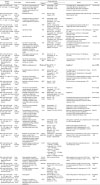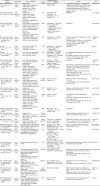1. Guo SS, Roche AF, Chumlea WC, Gardner JD, Siervogel RM. The predictive value of childhood body mass index values for overweight at age 35y. Am J Clin Nutr. 1994; 59(4):810–819.
2. Park HG. Childhood and adolescent obesity. Korean J Obes. 1998; 7(4):274–279.
3. Mossberg HO. 40-year follow-up of overweight children. Lancet. 1989; 334(8661):491–493.
4. Jung MS. A study on the relationship between obesity and lifestyle habits of middle school students in Seoul [master's thesis]. Yonsei University;1989.
5. Kim HR. A strategy for child and adolescent health promotion: nutrition, overweight and obesity. Forum Health Welf. 2008; 141:20–31.
6. Kim JH, Kim BH, Kim HK, Son SM, Mo SM, Choi HM. A study on food ecology according to obesity index of elementary school children in a high socioeconomic apartment complex in Seoul. Korean J Diet Cult. 1993; 8(3):275–287.
7. Jeon SY. The mediating effects of ego-resiliency on the relationship between child's obesity stress and depression. Korean J Manag Assoc. 2008; 26(5):155–163.
8. Emmett PM, Jones LR. Diet, growth, and obesity development throughout childhood in the Avon longitudinal study of parents and children. Nutr Rev. 2015; 73(Suppl 3):175–206.
9. Ebbeling CB, Pawlak DB, Ludwig DS. Childhood obesity: Public-health crisis, common sense cure. Lancet. 2002; 360(9331):473–482.
10. Brown CL, Halvorson EE, Cohen GM, Lazorick S, Skelton JA. Addressing childhood obesity: Opportunities for prevention. Pediatr Clin North Am. 2015; 62(5):1241–1261.
11. Wofford LG. Systematic review of childhood obesity prevention. J Pediatr Nurs. 2008; 23(1):5–19.
12. Yun SH, Kim HJ, Oh KW. Prevalence of obesity among children and adolescent in Korea. Center for Disease Prevention;2015. 10. Report No. 8.
13. Korea Centers for Disease Control and Prevention. The Korea youth risk behavior web-based survey [Internet]. Korea Centers for Disease Control and Prevention;2009. cited 2017 Jun 21. Available from:
https://yhs.cdc.go.kr/.
14. Korea Centers for Disease Control and Prevention. The Korea youth risk behavior web-based survey [Internet]. Korea Centers for Disease Control and Prevention;2012. cited 2017 Jun 21. Available from:
https://yhs.cdc.go.kr/.
15. Korea Centers for Disease Control and Prevention. The Korea youth risk behavior web-based survey [Internet]. Korea Centers for Disease Control and Prevention;2015. cited 2017 Jun 21. Available from:
https://yhs.cdc.go.kr/.
16. Lee TY, Nam TW, Cho IS. A study of planning of a nation-wide science information system for Korea. J Korean Soc Libr Inf Sci. 1997; 31(4):187–214.
17. Park YS, Lee DH, Choi JM, Kang YJ, Kim CH. Trend of obesity in school age children in Seoul over the past 23 years. Korean J Pediatr. 2004; 47(3):247–257.
18. Park SJ. A survey on the fatness extent of middle school students in Seoul, on their habit and on their tendency [master's thesis]. Sejong University;2002.
19. Shin M, Jeon SH, Yoo MS. A study on factors affecting life satisfaction and wellbeing in youth. Korean J Youth Stud. 2010; 17(9):131–150.
20. Lee HS. The effect of nutrition education and exercise intervention on nutrient intakes, body composition, serum lipids and physical fitness in obese women [master's thesis]. Ewha Womans University;2010.
21. Shirai K, Shinomiya M, Satio Y, Umezono T, Takahasi K, Yoshida S. Incidence of childhood obesity over the last 10 years in Japan. Diabetes Res Clin Pract. 1990; 10(1):S65–S70.
22. Park HW. A study on the antecedents (temperament and eating environment) of eating habits in young children and their developmental changes. Korean J Hum Dev. 1996; 3(1):25–43.
23. Park YS, Chun HJ, Song BK. Determining obesity frequency of rural children by skinfold thickness, analyzing their KAP related to obesity and obesity camp strategy. Korean J Community Nutr. 2000; 5(3):502–512.
24. Lee HH, Choi SK, Seo JS. Obesity index and related factors among elementary school students visiting pediatric department of general hospital. Korean J Diet Assoc. 2012; 18(2):186–199.
25. Han JS, Rhee SH. The relationship between serum cholesterol level and dietary intake in obese children. Korean J Soc Food Nutr. 1996; 25(3):433–440.
26. Son SM, Lee JH. Obesity, serum lipid and related eating behaviors of school children. Korean J Community Nutr. 1997; 2(2):141–150.
27. Yim KS, Yoon EY, Kim CI, Kim KT, Kim CI, Mo SM. Eating behavior, obesity and serum lipid levels in children. Korean J Nutr. 1993; 26(1):56–66.
28. Park KW, Lee KY, Park TJ, Kwon ER, Ha SJ, Moon HJ. The factors associated with becoming obese children: in 6th grade children of elementary schools in Busan. Korean J Fam Med. 2003; 24(8):739–745.
29. Moon SS, Lee YS. Comparison of dietary habits, exercise, recognized body shapes and weight control between obesity and underweight of adolescents. Korean J Hum Ecol. 2009; 18(6):1337–1348.
30. Kim MH. Eating habit, body image, and weight control behavior by BMI in Korean female high school students: Using Korea youth risk behavior web-based survey 2010 data. Korean J Food Nutr. 2012; 25(3):579–589.
31. Han YS, Joo NM. An analysis on the factors of adolescence obesity. J Korean Soc Food Cult. 2005; 20(2):172–185.
32. Choi JI, Kang H. An investigation of factors influencing adolescents' obesity. Korea Sport Res. 2003; 14(6):1921–1931.
33. Bae YJ, Kim EY, Cho HK, Kim MH, Choi MK, Sung MK. Relation among dietary habits, nutrient intakes and bone mineral density in Korean normal and obese elementary students. Korean J Community Nutr. 2006; 11(1):14–24.
34. Lee HS, Jeong WS, Park UI. Blood lipid level, nutrient intake, self-esteem and physical activity of obese and normal weight elementary school children. Korean J Diet Assoc. 2006; 12(2):146–156.
35. Kim MJ. The effect of eating habit, life behavior and body image of higher grade elementary school children and parents in child obesity degree. Korean J Growth Dev. 2013; 21(3):227–235.
36. Lee SA, Bae YJ, Sung CJ. A study on nutritional status of iron in Korean normal and obese male elementary school students. Korean J Diet Assoc. 2006; 12(1):55–67.
37. Kim MJ. The effect of eating habit and life behavior of elementary school children and parents in child obesity. Korean J Growth Dev. 2012; 20(1):9–15.
38. Kim JD, Kim WK, Rhim YT, Kim MJ. The difference for eating, activity, life pattern between obese and normal child who 5-6 grade in elementary school. J Sport Leis Stud. 2009; 38(2):855–865.
39. Kim EK, Lee AR, Kim JJ, Kim MH, Kim JS, Moon HK. The difference of biochemical status, dietary habits and dietary behaviors according to the obesity degree among obese children. Korean J Diet Assoc. 2000; 6(2):161–170.
40. Lee JR, Park CM. Study on an actual condition and relevant factors of obesity of elementary school students. Korean J Health Educ Promot. 2004; 21(2):35–54.
41. Yang KH, Kim YH. The factors related to obesity level of upper level elementary students. Korean J Health Educ Promot. 2004; 21(2):133–146.
42. Park KJ. A study on analysis of obesity factors in elementary school children. Korean J Phys Educ Assoc Girls Women. 2001; 15(1):57–67.
43. Kim MK, Kim HJ, Kim YO, Lee JH, Lee WC. Overweight among preschool children in Seoul: prevalence and associated factors. Korean J Community Nutr. 2001; 6(2):121–129.
44. Lee JB, Lee JO, Kim SW, Kang JH, Yang YJ. The prevalence and risk factors of childhood obesity in elementary students in Seoul. J Korean Acad Fam Med. 2000; 21(7):866–875.
45. Kim YK, Chyun JH. Food habits and its relation to the obesity of preschool children living in urban area. Korean J Diet Cult. 2000; 15(5):349–360.
46. Lee YJ, Chang KJ. A comparative study of obese children and normal children on dietary intake and environmental factors at an elementary school in Inchon. Korean J Community Nutr. 1999; 4(4):504–511.
47. Kang YR. A retrospective study on the prevalence of obesity in elementary school children. Korean J Diet Assoc. 1996; 2(2):168–180.
48. Kang YR, Paik HY. A study on the etiology of childhood obesity. J Nutr Health. 1988; 21(5):283–294.
49. Cha MS. A study on obese elementary school children in Seoul. J Elementary Educ. 1988; 2(1):55–73.
50. Heo GJ, Nam SY, Lee SK, Chung SJ, Yoon JH. The relationship between high energy/low nutrient food consumption and obesity among Korean children and adolescents. Korean J Community Nutr. 2012; 17(2):226–242.
51. Bae YJ. Evaluation of nutrient intake and anthropometric parameters related to obesity in Korean female adolescents according to dietary diversity score: From the Korean National Health and Nutrition Examination Surveys, 2007-2009. Korean J Community Nutr. 2012; 17(4):419–428.
52. Kim JY, Han YS, Bae HS, Ahn HS. Dietary intakes and serum lipids and iron indices in obese children. Korean J Community Nutr. 2006; 11(5):575–586.
53. Lee JC, Kim MH. A study on dietary related factors and blood parameters of obese children residing in Samcheok. Korean J Diet Assoc. 2005; 11(2):190–204.
54. Ko SH, Yu HR. The influences of energy consumption on obesity and physical fitness. Korean J Phys Educ. 1998; 37(1):161–172.








 PDF
PDF ePub
ePub Citation
Citation Print
Print






 XML Download
XML Download